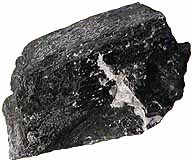
NPS Photo There are two kinds of schists found in the canyon: either a mica-rich schist, that has a lot of biotite and muscovite mica, or a schist rich in hornblende, a type of mineral called amphibole. A zone of schist crosses the canyon between Gunnison Point and Pulpit Rock Overlook. Rare minerals such as garnets, sillimanite, staurolite or andalusite can be common in places. Location Some of the best places to see schist are among the spires at Gunnison Point Overlook or Kneeling Camel View. The Great Pillars are among the largest examples of schist in the canyon. 
HornblendeHornblende is a member of the solid solution series for amphiboles. Hornblende is the most common occurring amphibole in the canyon and is black or dark green in color. When it fractures, it tends to break at either 60 or 120 degree angles. It contains significant amounts of potassium and fluorite in its chemical formula, which helps determine the color of the mineral. It sometimes forms large masses known as amphibolite or hornblende schists that are made up of thin, black parallel aligned, needle-like crystals. |
Last updated: April 24, 2025
